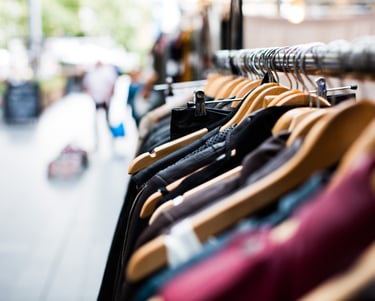Sustainability in retail fashion - where we are and where things are going
A growing concern in retail fashion, here are some of the biggest sustainability trends happening now, plus a peek at what might be around the corner.
NEW NORMALDIGITAL ACCELERATIONMARKETINGCHANGESUSTAINABILITY
Clothing manufacturing uses 93 billion cubic metres of water annually


As practitioners in a rapidly moving digital world, we’re always watching the zeitgeist. And you can’t help but notice the sustainability revolution happening in the fashion industry right now.
Consumers have swung away from Forever 21 and ASOS-fueled fast fashion towards a slower, more accountable approach. Clothing buyers are demanding higher standards from brands than ever, at every step of the journey.
Thanks to the digital world’s mountains of data, we now understand just how wasteful fashion can be. Geneva Environment Network reports that fashion production makes up 10% of humanity’s carbon emissions. Making our clothing uses 93 billion cubic metres of water annually, which is enough to meet the needs of five million people. And that’s just the beginning.
Given these facts and what we know about the looming climate crisis, it’s not surprising consumers are asking brands to do better.
Sustainability Trends in Retail Fashion
We don’t claim to be experts in corporate social responsibility, but we work with clients who sell DTC products. And, sustainability continues to be a focus across consumer industries. In any case, here are a few things we’ve noticed:
There’s a new wave of progress happening
Companies are making an impact through reduced packaging, switching to organic and lower-chemical fabrics, and using renewable materials. Others develop made-to-order business models and repair programs. Meanwhile, the outdoor industry has banded together with a pledge to become climate positive by 2030.
Sustainability pledges are the norm on corporate websites these days, but some brands and industries are blazing the trail with their efforts. Designers like Eileen Fisher and Stella McCartney often receive high marks for their strides in sustainability. And UK’s Youswim is catching positive attention with their sustainably-made “swimsuits for life”.
But it’s complicated
The problem of sustainability in fashion is multi-faceted and spans cultural, economic, and ethical systems. Thus, the path to more sustainable fashion is complex, with no singular way forward.
When it comes to evaluating the harsh environmental impact of our clothes, consumers and brands need to consider a matrix of sourcing concerns, chemical waste, production levels, CO2 emissions, pollution, effects on biodiversity, fair wages, safe working conditions, and more.
A brand may be good in one of those aspects and dismal in another. What’s a socially conscious buyer to do?
Consumers can spot greenwashing straightaway
Brands quickly jumped on the green bandwagon—and just as quickly manipulated it to fit their needs. But consumers are smart enough to recognise smoke and mirrors.
Shoppers know not to take labels boasting “sustainable”, “eco-friendly”, “conscious” and “responsible” at face value. They do their own (sometimes extensive) research to see if brands can back up their claims. There’s a whole wave of social media influencers who’ve built communities around sharing their ratings of brands, pushing the industry forward as a result.
Third party & independent certifications matter
Third party certifications have emerged as one of the best ways for consumers to vet brands. How sustainable is Primark, Amazon, or any brand for that matter? As we said before, it’s complicated.
But scientists and other experts have begun tracking the complex journey from materials to finished product, helping to create standards and allow manufacturers to understand the impact of the materials and processes they use.
For example, certifications like FairTrade, bluesign® and FSC hold producers accountable for resource and chemical use, pollution, fair working practices and more. Eco-conscious consumers know and look for these certifications. And apps like Good on You align with United Nations Sustainable Development Goals and other transparent data to provide trustworthy and independent ethical brand ratings.
We still have a long way to go
Every action sustainable fashion brands take is a worthy step toward reducing the industry’s carbon footprint. But we’re not where we need to be—not even close.
As it stands, the fashion industry is responsible for more than 1.2 billion tons of greenhouse gases each year (around 10% of the world’s carbon footprint). And that’s not even counting the impact of delivery services and other industry related impacts.
Sustainability has become a buzzword, for sure. But there seems to be a growing recognition that not only do consumers expect change, it’s the right thing to do. Still, a mindset shift is needed if progress is meant to speed up.
For now, most brands still see responsible practices like wear-forever clothing and product repair programs as counterintuitive to profitability. But trailblazers like Patagonia and REI have shown how it can amount to increased, even cultish, brand loyalty in the end.
So, we’ll see how long it takes brands to catch on and realise that a lifelong customer is more important than a single sale. And let’s hope we have time to wait until they do.
Related reads & resources:
Man vs. the Machine: The Future of AI in Retail and Digital Commerce
How a Holistic Vision Can Help You Solve More Business Problems, Faster
The Importance of Strong Digital Leadership in 2022 and Beyond
